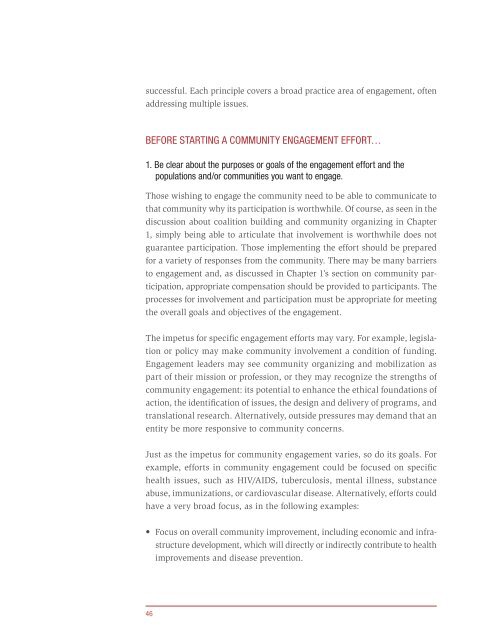Principles of Community Engagement (Second Edition)
Principles of Community Engagement (Second Edition)
Principles of Community Engagement (Second Edition)
Create successful ePaper yourself
Turn your PDF publications into a flip-book with our unique Google optimized e-Paper software.
successful Each principle covers a broad practice area <strong>of</strong> engagement, <strong>of</strong>ten<br />
addressing multiple issues<br />
BEFORE STARTING A COMMUNITY ENGAGEMENT EFFORT…<br />
1. Be clear about the purposes or goals <strong>of</strong> the engagement effort and the<br />
populations and/or communities you want to engage.<br />
Those wishing to engage the community need to be able to communicate to<br />
that community why its participation is worthwhile Of course, as seen in the<br />
discussion about coalition building and community organizing in Chapter<br />
1, simply being able to articulate that involvement is worthwhile does not<br />
guarantee participation Those implementing the effort should be prepared<br />
for a variety <strong>of</strong> responses from the community There may be many barriers<br />
to engagement and, as discussed in Chapter 1’s section on community participation,<br />
appropriate compensation should be provided to participants The<br />
processes for involvement and participation must be appropriate for meeting<br />
the overall goals and objectives <strong>of</strong> the engagement<br />
The impetus for specific engagement efforts may vary For example, legislation<br />
or policy may make community involvement a condition <strong>of</strong> funding<br />
<strong>Engagement</strong> leaders may see community organizing and mobilization as<br />
part <strong>of</strong> their mission or pr<strong>of</strong>ession, or they may recognize the strengths <strong>of</strong><br />
community engagement: its potential to enhance the ethical foundations <strong>of</strong><br />
action, the identification <strong>of</strong> issues, the design and delivery <strong>of</strong> programs, and<br />
translational research Alternatively, outside pressures may demand that an<br />
entity be more responsive to community concerns<br />
Just as the impetus for community engagement varies, so do its goals For<br />
example, efforts in community engagement could be focused on specific<br />
health issues, such as HIV/AIDS, tuberculosis, mental illness, substance<br />
abuse, immunizations, or cardiovascular disease Alternatively, efforts could<br />
have a very broad focus, as in the following examples:<br />
• Focus on overall community improvement, including economic and infrastructure<br />
development, which will directly or indirectly contribute to health<br />
improvements and disease prevention<br />
46

















